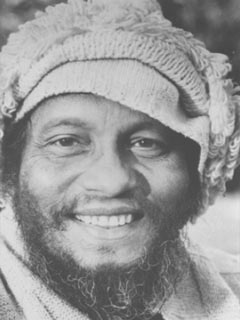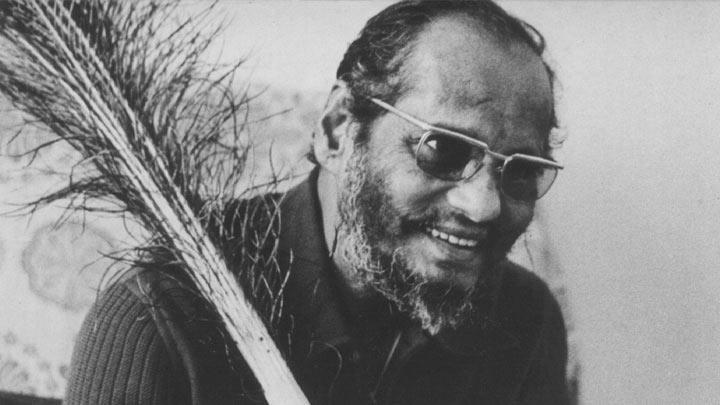 Swami Muktananda was affectionately known by all as simply Baba. He was drawn to the spiritual path early in life after meeting the great ascetic yogi Bhagavan Nityananda.
Swami Muktananda was affectionately known by all as simply Baba. He was drawn to the spiritual path early in life after meeting the great ascetic yogi Bhagavan Nityananda.
Following this encounter, he left home to wander throughout India, took initiation as a monk, and became Swami Muktananda. He studied yoga, Ayurvedic medicine, Indian martial arts, and the Vedic scriptures, and learned from many great yogis and saints.
Meeting Nityananda again years later in Ganeshpuri, he received a powerful spiritual transmission. This precipitated an intensive nine years of meditation practice, which culminated when Nityananda advised his students, Muktananda has become enlightened, he is liberated. Prior to his own passing in l961, Bhagavan Nityananda encouraged his disciple to live nearby and predicted his spiritual accomplishment and influence would spread very wide in the future.
“Meditate on your Self, Worship your Self, Kneel to your Self, Honor your Self, God dwells within you as you.” – Baba Muktananda
Complying with this request from his Guru, Muktananda made three world tours, during which he brought spiritual awakening, meditation, and chanting to thousands. He first travelled to Australia, the United States, and Europe in 1970. In that time of social and political upheaval, his message about discovering one’s own inner wealth held particular resonance: Look within for happiness. Honor your Self. Love your Self. God dwells within you as you.
Baba spoke in Hindi and his words were translated into English, yet his communication was beyond language and culture. Audiences experienced his blissful energy and were enchanted by his warmth, his mischievous humor, and the joyful spontaneity that informed his every gesture. Baba was a perfect manifestation of his name, Muktananda, which means the bliss of freedom.
Following Baba’s return to India late in 1970, Westerners began to visit his ashram, Shree Gurudev Ashram (later called Gurudev Siddha Peeth), two hours north of Mumbai in Maharashtra state. He instilled strict discipline through a daily routine with periods of chanting, seva, and meditation. Hippies travelling through India looking for the endless high were either transformed by the routine or quickly moved on. Devotees from Mumbai, Delhi, and other parts of India came for weekends and celebrations. The temple and the halls resonated with melodic Sanskrit chanting and bhajans.

Baba’s ashram took on the quality of an emperor’s court, with a steady line of faithful coming for spiritual advice, and to make offerings of flowers and fruit. The lines included well-known Indian musicians who offered their talents, local and national politicians, intelligentsia, Bollywood film stars, and an endless stream of pilgrims who saw him as the living embodiment of the tradition of enlightened yogis.
His reputation as a meditation master spread throughout the United States, Europe, and Australia. His spiritual autobiography, Chitshaktivilas (later called Play of Consciousness) was published in 1971 by Harper and Row. In it, Baba documented his devotional relationship with his Guru, and the remarkable spiritual unfolding that had resulted from the transmission of spiritual energy he received.
Werner Erhard, whose EST seminars for personal transformation became popular in the US, met Baba in Ganeshpuri in 1973 and invited him to visit the US again. Baba accepted, and announced he would conduct a meditation revolution. During this second world tour (1974-1976), he initiated many through Intensives, a weekend experience of chanting, meditation, and Vedic knowledge. He walked among the meditators, touching them with his hands and with a peacock feather wand, and transmitting the energy of spiritual awakening, known as shaktipat. For some, the effects were subtle, bringing deep meditative stillness. For others, the awakening was more dramatic. While remaining in meditation, people laughed, cried, swayed. Later all had the opportunity to share their experiences.
Among the many Westerners who came seeking spiritual insight from Baba were scientists from Stanford Research Institute, who brought instruments with which they hoped to measure his higher states of consciousness. Baba found this amusing, and ended up introducing the scientists to his own laboratory where they discovered meditation. Politicians, writers, actors, artists, and spiritual teachers came to inquire and pay their respects. People came by the hundreds to sit in the presence of a living meditation master who could transmit a direct experience of inner joy and wisdom. Baba said, Meditation is universal. It is not the property of any particular religion or nationality. Through meditation, we become aware of the fundamental unity of all creation.
Baba and his caravan swept through the US via Route 66, conducting Intensive retreats in New Mexico, Colorado, Utah, Oklahoma, Michigan, and New York. He left in his wake students who were filled with enthusiasm for chanting and meditation, and committed to serving their Guru. Siddha Yoga Dham Associates (SYDA) was formed, and meditation centers and ashrams were founded in Oakland and Los Angeles, California; South Fallsburg, New York; Ann Arbor, Michigan; Melbourne and Sydney, Australia; and London, England; among other places.
Baba spent two years in the West teaching meditation, awakening individuals to the richness of their inner Self. He was featured prominently in magazines, television documentaries, and newspaper articles. An article in Time magazine recognized his rare accomplishments and described him as the Guru’s Guru.
In 1976, Baba departed on a jumbo jet with 400 devotees. They found the courtyard of Shree Gurudev Ashram filled with bejewelled elephants, musicians playing, and villagers chanting ecstatically. Lines of pilgrims wound through the marble courtyard as Baba greeted each person with warmhearted respect. He gave of himself, constantly expressing his devotion for his own Guru and affirming that everything that happened in his presence occured through the grace of Bhagavan Nityananda.
Baba insisted on setting aside traditional caste distinctions. All pilgrims, whether famous or simple villagers, were received equally and shared meals in the spacious dining hall. Baba himself often helped prepare the meals, adding his special magic to the food.
Throughout these years, although Baba experienced several serious illnesses, he demonstrated the extraordinary capacity of a yogi to remain unaffected by physical limitations. His students coud see that the power of the mind was greater than any karmic obstacles arising as illness.
Baba maintained a delicate balance between the popularity he received from his world tours and the traditional institutions of Indian culture. The majority of his students returned to their homes, and he encouraged them to meditate and deepen their spiritual understanding, and to integrate that into their lives. He also instituted a traditional order of monastics. Both Western and Indian swamis were initiated by Mahamandaleshwar Swami Brahmananda Giri from Haridwar. They were trained and sent to teach, run Intensives and courses, and represent Baba in his expanding centers throughout the world.
During his third world tour (1978-1981) Baba’s teaching penetrated the mainstream of the prevailing Western culture. Programs such as the Prison Project and large conferences for psychologists, actors, and creative artists demonstrated the practical and transformational benefits of meditation and the exploration of consciousness. The SYDA Foundation was expanded, making Baba’s teachings more available internationally.
In July 1981, as Baba was concluding a celebration at the Shree Nityananda Ashram (later Shree Muktananda Ashram) in South Fallsburg, New York, he called the then newly appointed Swami Nityananda forward. He placed a garland around his neck and announced to the hundreds of people present, This man will be my successor.
Some time later, he announced that Swami Nityananda’s sister, Swami Chidvilasananda, would be a co-successor. In May 1982, Baba formally established Swami Nityananda and Swami Chidvilasananda so they could carry on his work.
Baba’s passing in October 1982 precipitated a period of progressive upheaval and evolution. It led three years later to the creation by Swami Nityananda of a new organization, Shanti Mandir, through which he pursues the legacy of Baba’s teachings, while Swami Chidvilasananda continues her work with the SYDA Foundation.


